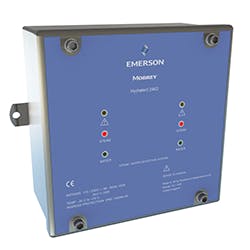Emerson’s water and steam detection system is reportedly the first single controller solution to be certified to IEC 61508 for safety instrumented functions up to SIL 3. The Mobrey Hydratect 2462 Water and Steam Detection System is used in applications where the detection of water or steam is vital for safe and efficient plant operation, such as boilers, steam drums and steam line drain pots. The Hydratect system is suited for demanding applications within power generation, refineries, chemical, steel, pulp and paper plants. It can operate in process conditions of up to 300 bar and 560°C.
Hydratect is a modern replacement for conventional float switches, and consists of a compact twin-channel electronic unit, connected to a pair of electrodes. Each channel gives independent indications of the presence of water or steam that are reportedly more reliable than those obtained with electro-mechanical devices, which have the possibility of failing in an unsafe condition. By installing the electrodes in vessels or steam lines and measuring the resistance, the presence of water can be detected, allowing appropriate safety measures to be taken.
By detecting low water level in steam drums, Hydratect helps to prevent boiler tubes overheating, which could lead to an explosion, while detecting high water level prevents the generation of wet steam which could cause costly turbine blade erosion. Using Hydratect to detect water in steam line drain pots, as part of a turbine water induction prevention system (TWIP), helps prevent damage to turbine blades, cylinders and the housing, according to Emerson.
The electronics unit provides a local indication of steam, water and fault states, and features configurable fault and trip outputs. Component failure, cable faults, ground faults and electrode problems are continuously self-monitored. Additional reliability is provided by triple redundancy of critical components, which ensures that failures result in a safe condition, according to Emerson, and an individual power supply to each channel.
